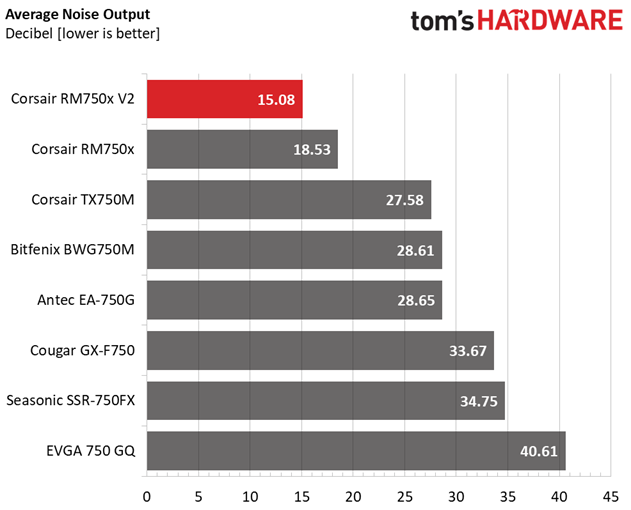Corsair RM750x PSU Review: Improving On A Classic
Why you can trust Tom's Hardware
Performance, Value, Noise & Efficiency
Performance Rating
The following graph shows the RM750x’s total performance rating, comparing it to other units we have tested. To be more specific, the tested unit is shown as 100 percent, and every other unit's performance is shown relative to it.
Corsair's new RM750x achieved identical performance as its predecessor, despite a notably smaller form factor. Ideally, though, it would have performed better than the old RM750x.
Performance Per Dollar
The following chart may be the most interesting to many of you because it depicts the unit's performance-per-dollar score. We looked up the current price of each PSU on popular online shops and used those prices and all relative performance numbers to calculate the index. If the specific unit wasn't available in the United States, we searched for it in popular European Union shops, converting the listed price to USD (without VAT). Note that all of the numbers in the following graph are normalized by the rated power of each PSU.
Since the old and new RM750xes share a similar price tag, their value ratings are the same. At the time this review was written, the RM750x was listed at $120 (notably more expensive than the $104 Seasonic SSR-750FX). Now you can find Corsair's PSU for $110 or so.
Noise Rating
The graph below depicts the cooling fan's average noise over the PSU's operating range, with an ambient temperature between 30°C and 32°C (86°F to 89.6°F).
This is where the new RM750x excels. Its predecessor was already very quiet. But the second-gen version outperforms it by outputting 15 dB(A) overall. Seasonic's SSR-750FX, which is one of the most popular 750W PSUs out there, lands closer to 35 dB(A).
Efficiency Rating
The following graph shows the RM750x's average efficiency throughout its operating range, with an ambient temperature close to 30°C.
Get Tom's Hardware's best news and in-depth reviews, straight to your inbox.
Although the new RM750x lands close to the older model's overall efficiency, we would like to see it place higher on this chart. Ideally, it'd reach 89%.
MORE: Best Power Supplies
MORE: How We Test Power Supplies
MORE: All Power Supply Content
Current page: Performance, Value, Noise & Efficiency
Prev Page EMC Pre-Compliance Testing Next Page Final Analysis
Aris Mpitziopoulos is a contributing editor at Tom's Hardware, covering PSUs.
-
joedavies87 I bought one last year and did not realize that I would need two EPS cables for future builds. Moved to EVGA. Corsair was too late.Reply



